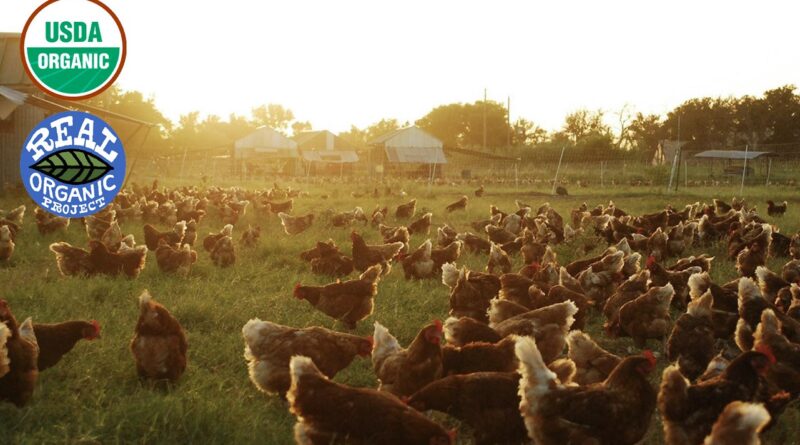Reclaiming Real Organics
Podcast: Play in new window | Download (Duration: 1:57:56 — 55.8MB)
Subscribe: Apple Podcasts | Spotify | Android | iHeartRadio | Podchaser | Email | TuneIn | RSS | More
(January 10, 2021 – Photo courtesy of Coyote Creek Farm, TX) I became aware of a group called the Real Organic Project a few short months ago. It was in a newsletter called GreenTalks, which is part of Ball Publishing‘s stable of horticultural publications. Reporter Jennifer Duffield White wrote about how the organization’s goal of reclaiming real organics was moving forward with the official launching of its new label.
So while there isn’t necessarily an organics “war” in the United States, there is certainly a disagreement about what the word “organic” means in regard to our food supply. In a story that came out about the same time as the GreenTalks article, Civil Eats reported on the increase in organic food sales. It noted that
organic food sales have doubled over the past decade to $50.1 billion in 2019, according to the 2020 Organic Industry Survey released by the Organic Trade Association (OTA). Nearly 6 percent of the food Americans now eat is organic.
Those numbers have only gone up during the pandemic. That might be the silver lining in very hard times, if only those sales hadn’t come at the expense of small farmers.
…while smaller organic farmers may thrive through direct sales, they can’t often sell their products to grocery stores, said Dixon. Because of the power they yield in the marketplace, large-scale organic farms are undercutting small and mid-size farms in retail sales and in some cases pushing them out of business, she said. This includes milk from organic mega dairies whose cows produce more than 450 small dairies put together and poultry raised in large chicken barns that feature tiny, screened-in porches as “outdoor access.”
One of the biggest threats to smaller-size farmers, according to proponents of Real Organic, comes from organic hydroponic operations, which grow produce without soil, using a substrate such as coconut husks, and rely on a liquid feed to supply nutrients to the plants. Such practices, said soil-based blueberry farmer Hugh Kent, give hydroponic farms an unfair advantage and go against the original intention of the USDA organic standards, which focused on improving soil fertility, rather than simply cutting out certain pesticides and synthetic fertilizer.
Indeed, the Real Organic Project argues that reclaiming real organics means going back to the motto, “feed the soil, not the plant.” They believe that philosophy has been undermined by recent USDA decisions.
…in recent years, the USDA has changed their definition by allowing large-scale certification of vegetables and berries grown hydroponically without any soil at all. They have allowed industrial confinement operations, that provide animals zero access to soil, to become certified organic.
Organic farmers have long known that healthy soil creates nutritious food, healthy people, and a healthy environment. This leaves us to wonder, what does USDA Organic mean now? How can we protect the movement that organic family farmers have built?
One way is to add their own Real Organic label on top of USDA standards.
Today, Ariel Pressman from Real Organic Project joins us to talk about how ROP is reclaiming real organics. He is the Director of Certification, where he supervises the more than 450 Real Organic Project farms across the country. Previous to his work with ROP Ariel spent 8 years managing his certified organic vegetable farm, Seed to Seed, located in Western Wisconsin.
In addition to telling us about the work of ROP, Pressman talks about the Real Organic Symposium, being held every Sunday from 3-5pm EST (2-4pm CST) in January. More than 60 prominent organic farmers and experts discuss soil health, nutrition, climate change and “What can we do next?”. Attendees can choose between a Live Access Interactive Ticket or a pass to view the recorded content. According to ROP, more than 1400 people are registered, with over 600 of them farmers and students who get free or half priced tickets.
Growing Gardeners During a Pandemic Part II
I used above headline just two months ago, when I wrote about interviewing Chris Beytes of the GrowerTalks. He had written this to me.
I can tell you that, as of April 29 when you queried me, I still didn’t quite know how the garden business was going to fare. Now I can tell you that many growers and retailers had record years, and by one industry company’s reckoning, there were 16m to 20m new gardeners “born” in the pandemic.
The company he refers to is Bonnie Plants, the single largest purveyor of vegetable and herb plants in the country. But I had been hearing the very same thing throughout 2020. So I wasn’t surprised, but I was pleased, when Peggy and I received this email less than a week later.
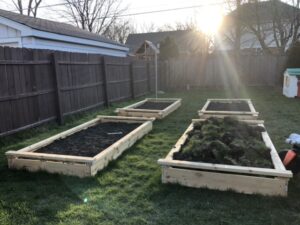 I am a very new very green gardener making plenty of rookie mistakes, but I have been incredibly lucky to have come across your podcast. You have encouraged me to step out of my comfort zone when it comes to my home garden and inspired me to take the knowledge I have learned from your broadcasts and share them with my community.
I am a very new very green gardener making plenty of rookie mistakes, but I have been incredibly lucky to have come across your podcast. You have encouraged me to step out of my comfort zone when it comes to my home garden and inspired me to take the knowledge I have learned from your broadcasts and share them with my community.
The writer, Alexandria Zuck, also informed us that she worked at a large hospital in the Chicago area and that last year, predictably, had been a challenge.
That got my wheels turning, and I knew I wanted to talk to her on the show. It took a little while, but Alexandria joins us this morning to talk about what it’s been like to jump feet first into gardening. Here’s how she describes it.
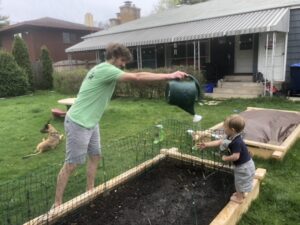 Professionally, I am an acute care Physical Therapist working at a large trauma center on the South Side of Chicago. This past year shook me to my core, tugging and pulling at the very roots of my being. I remember late night news binges, confusion and uncertainty at work and at home. Then everything got quiet; the hospital hallways emptied of people and were replaced with red tape marking modified COVID units. Staffing became limited as the hospital worked to understand what was happening and how we could still provide the safest best care possible. The next thing I knew I was no longer surrounded by the hustle of the hospital with its variety of disinfectants and beeps, instead I was home, everybody was home. The high pitched frequency of the hospital dulled
Professionally, I am an acute care Physical Therapist working at a large trauma center on the South Side of Chicago. This past year shook me to my core, tugging and pulling at the very roots of my being. I remember late night news binges, confusion and uncertainty at work and at home. Then everything got quiet; the hospital hallways emptied of people and were replaced with red tape marking modified COVID units. Staffing became limited as the hospital worked to understand what was happening and how we could still provide the safest best care possible. The next thing I knew I was no longer surrounded by the hustle of the hospital with its variety of disinfectants and beeps, instead I was home, everybody was home. The high pitched frequency of the hospital dulled 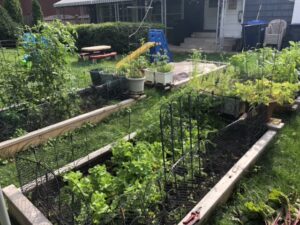 to a constant buzz of quarantine. Early March, while the news reported the latest stats and trends tracking the virus, I was dreaming of, researching, and drafting plans for my garden. When others were clearing the aisles of the grocery store I was scouring local hardware stores and nurseries grabbing whatever I had seen might grow in Chicago. There were many set-backs and mistakes, in starting the garden, but with each challenge I was gifted an opportunity to grow; I was able to test new skills and adapt old ones. As a physical therapist I work to encourage patience and perseverance in each of my patient’s. The garden offers me the same grace I strive to offer others. It has helped better me in all aspects of my life both at home and professionally. COVID took so much this year, but through my garden I was able to move towards a more balanced life, for that I am grateful.
to a constant buzz of quarantine. Early March, while the news reported the latest stats and trends tracking the virus, I was dreaming of, researching, and drafting plans for my garden. When others were clearing the aisles of the grocery store I was scouring local hardware stores and nurseries grabbing whatever I had seen might grow in Chicago. There were many set-backs and mistakes, in starting the garden, but with each challenge I was gifted an opportunity to grow; I was able to test new skills and adapt old ones. As a physical therapist I work to encourage patience and perseverance in each of my patient’s. The garden offers me the same grace I strive to offer others. It has helped better me in all aspects of my life both at home and professionally. COVID took so much this year, but through my garden I was able to move towards a more balanced life, for that I am grateful.Do we have the best listeners or what? But wait, there’s more! Yet another pandemic-inspired gardener joins us this morning. Her name is Megy Karydes and she’s a friend of the show as well as a Chicago-based communications consultant, writer and master gardener-in-training. Here’s what she wrote.
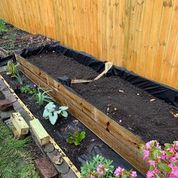 We have a pretty large backyard by Chicago home standards but because we never knew what to grow, we would just grow tomatoes and cucumbers. We never had much time to devote to it – until last year. With the help of my mom, who is a gardening pro, I learned the importance of good soil and what types of plants would do well in my garden as well as their placement (way more important than I ever realized). Through an active neighborhood group, I got my first seeds and that was it: I was hooked. The first day I saw those seeds sprout into little plants, I cried. It felt so hopeful during a time where little hope was available. I babied those plants. My husband helped by making us raised beds and filling it with organic soil and compost. We began pulling up grass and replacing it with native perennials. Luckily, I still had some work to do for clients and writing to do for editors but I was able to do that around my gardening time.
We have a pretty large backyard by Chicago home standards but because we never knew what to grow, we would just grow tomatoes and cucumbers. We never had much time to devote to it – until last year. With the help of my mom, who is a gardening pro, I learned the importance of good soil and what types of plants would do well in my garden as well as their placement (way more important than I ever realized). Through an active neighborhood group, I got my first seeds and that was it: I was hooked. The first day I saw those seeds sprout into little plants, I cried. It felt so hopeful during a time where little hope was available. I babied those plants. My husband helped by making us raised beds and filling it with organic soil and compost. We began pulling up grass and replacing it with native perennials. Luckily, I still had some work to do for clients and writing to do for editors but I was able to do that around my gardening time.
 This summer was unbelievable. By the end of it, we were canning so many tomatoes and freezing so much okra and green beans that I thought it’d be wise to buy a freezer — except by then they were all sold out. All told, we successfully grew about 15 different types of tomatoes, more than 100 onions, potatoes, 5 cucumbers, 12+ okra (we did it this time!), Swiss chard, green beans, celery and other herbs like basil, sage and dill. We weren’t successful with our broccoli, cauliflower, eggplant or watermelon.
This summer was unbelievable. By the end of it, we were canning so many tomatoes and freezing so much okra and green beans that I thought it’d be wise to buy a freezer — except by then they were all sold out. All told, we successfully grew about 15 different types of tomatoes, more than 100 onions, potatoes, 5 cucumbers, 12+ okra (we did it this time!), Swiss chard, green beans, celery and other herbs like basil, sage and dill. We weren’t successful with our broccoli, cauliflower, eggplant or watermelon.
Besides what I grew in my backyard, I nurtured a love for being outdoors and gardening. I decided to apply for and was accepted into the master gardener program through the University of Illinois Extension. I passed my final exam (with a 96%!) in December and now awaiting opportunities to complete my in-field volunteering so I can go from master gardener-in-training to master gardener. I started my own neighborhood gardening FB group page to complement the neighborhood gardening group and help others in my community get to know their gardening neighbors and share best practices, ideas, etc. I’m excited about the garden this year and looking forward to starting my seeds soon!
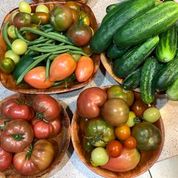 In addition, because she’s a communications pro, she sent us several articles about the prognosis for gardeners. The first, from Nursery Management, concerns a survey, “Gardening in a COVID-19 World.” It found that 86% of homeowners plan to continue gardening in 2021. The second is from something called Natural Awakenings Chicago. Hmm. I’ve heard of that before. Anyway, it’s about how to grow tomatoes and basil during the winter months. Yes, really.
In addition, because she’s a communications pro, she sent us several articles about the prognosis for gardeners. The first, from Nursery Management, concerns a survey, “Gardening in a COVID-19 World.” It found that 86% of homeowners plan to continue gardening in 2021. The second is from something called Natural Awakenings Chicago. Hmm. I’ve heard of that before. Anyway, it’s about how to grow tomatoes and basil during the winter months. Yes, really.

